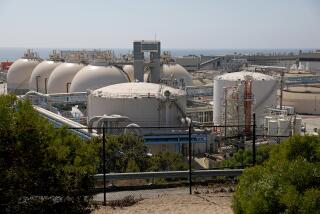Long Beach Seeks Trade-Offs on Incinerator’s Pollutant Emissions
- Share via
LONG BEACH — City officials are asking that the city’s new trash incineration plant be allowed to release more pollutants in short intervals, in exchange for reducing such emissions overall.
The $100-million plant, which burns trash to create electricity, has been plagued by occasional bursts of nitrogen oxide, a major component of smog. Operators try to control the bursts by injecting ammonia, which produces a chemical reaction that neutralizes the nitrogen oxide. The facility had operated under a variance that allowed for occasional emissions that exceeded 150 parts per million of nitrogen oxide.
But the variance expired Tuesday, which means that the plant will be subject to fines or other penalties if its pollutants exceed standards.
City public works officials who oversee the Southeast Resource Recovery Facility on Terminal Island want the plant’s output of nitrogen oxide to be measured every hour to determine whether it is violating air pollution standards. The emissions are now measured every 15 minutes.
Allows More Pollutants
That change to an hourly evaluation would have allowed the plant to spew another 430 pounds of pollutants a year, officials estimated.
But the city is also offering to lower its maximum amount of nitrogen oxide emissions on an hourly basis to 34 pounds, from the current 36 pounds. It would also reduce its maximum allowable output of nitrogen oxide by 17% per day, to 720 pounds. The changes are subject to approval by the South Coast Air Quality Management District.
City Solid Waste Manager Bill Davis said the hourly measurement is being sought because some operators are overreacting to the occasional pollution bursts by switching the plant off automatic control. In their hurry to fix the emissions within the 15 minutes, Davis said, the operators can overcompensate, which results in more pollution over a longer period.
If emissions were checked hourly, operators would be less likely to overreact in making corrections, and the plant would run cleaner overall, Davis said.
Plant engineer Charles Tripp said that overall, the facility has been emitting nitrogen oxide at levels about half of the maximum level permitted.
‘We Don’t Need the Variance’
Because the plant’s recent pollution levels have been within proper bounds, “basically, we said (they) don’t need the variance,” said Diana Love, chief prosecutor for the air quality district. From here on, “the plant is on its own.”
With the plant’s pollution problems nearly resolved, Davis said, the only major problem remaining is that the plant itself is consuming so much electricity that it does not produce as much to sell. If the problems went unfixed, the revenue generated by the plant from the electricity sales would be reduced by up to $1 million a year, he added.
Davis, at a meeting of plant’s board of directors this week, said the builder’s engineers are studying the problem.
Dravo Inc., which is building the facility, started a final 30-day test run of the plant Aug. 13 and will have to meet specifications to keep from having to compensate the city for defects or shortcomings.
More to Read
Sign up for Essential California
The most important California stories and recommendations in your inbox every morning.
You may occasionally receive promotional content from the Los Angeles Times.










